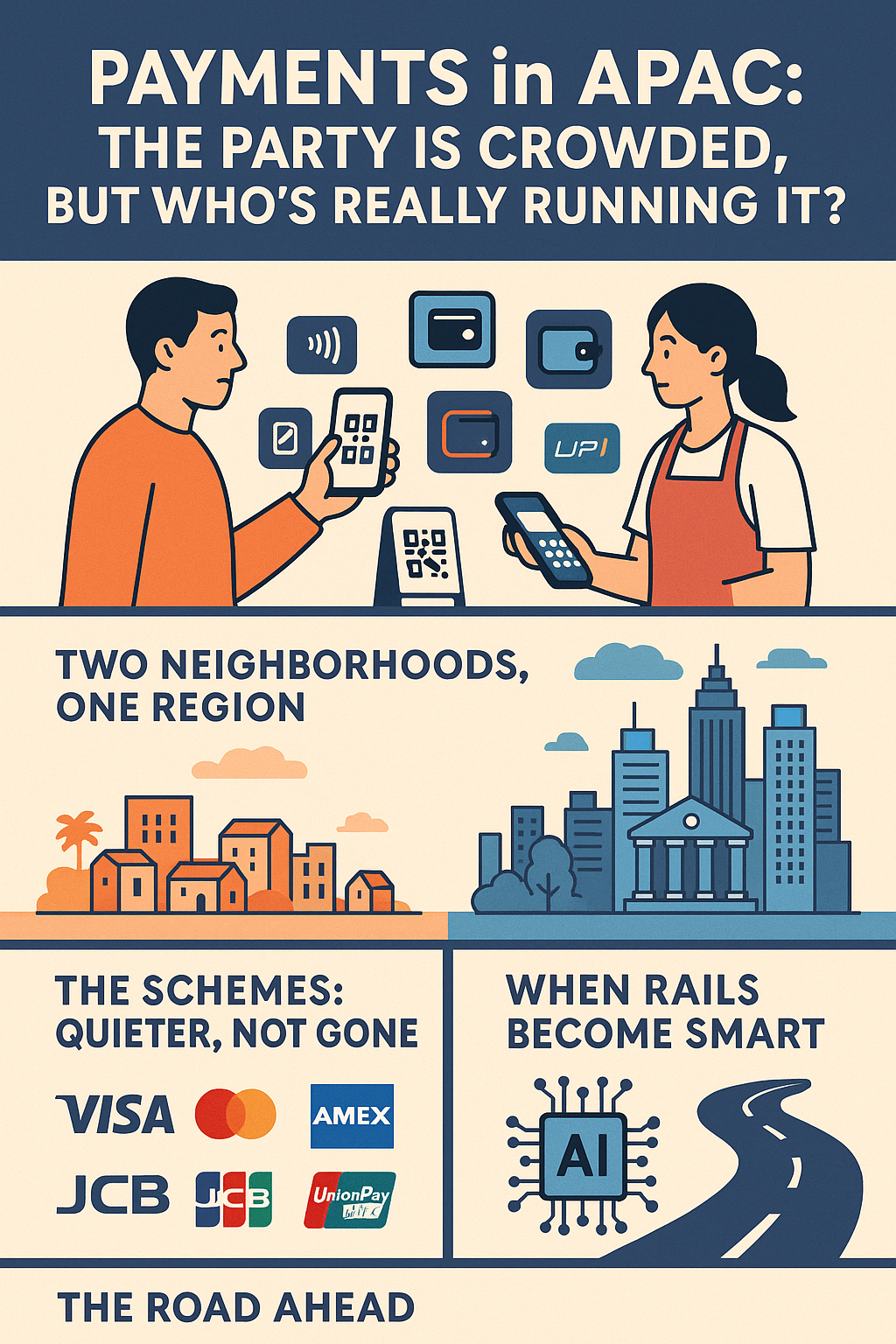Across the Asia-Pacific region, a universal scene unfolds at the checkout counter: a mosaic of QR codes, a battle for prime real estate on smartphone screens, and the rapid adoption of domestic real-time payment rails. It resembles a crowded party where every player is vying to control the music.
The critical question remains: who is the true host, and which players will endure when the tempo inevitably shifts?
Two Distinct Neighborhoods Within One Region
While geographically adjacent, Southeast Asia and North Asia represent fundamentally different paradigms in the payments landscape.
Southeast Asia: The Innovation Laboratory
Southeast Asia serves as a dynamic proving ground. The region is simultaneously experimenting with every available payment rail—QR codes, digital wallets, super-apps, and domestic account-to-account (A2A) infrastructure. Merchant acquisition is a fiercely competitive arena characterized by:
- Government-led initiatives promoting zero-MDR QR code acceptance.
- Wallet providers engaging in aggressive cashback wars to subsidize user acquisition.
- Super-apps leveraging payments as a core feature within bundled ecosystems like food delivery, ride-hailing, and e-commerce.
The environment is fragmented and intensely competitive, yet it boasts undeniable growth. For many consumers, digital wallets are the gateway to financial services. For merchants, the choice often boils down to whichever solution delivers customers at the lowest cost.
North Asia: The Established Boardroom
In stark contrast, North Asia (Japan, South Korea, Taiwan, Hong Kong) operates with the maturity of established markets where card-based payments are deeply entrenched. The landscape is orderly, structured, and driven by loyalty. While digital wallets exist, they typically operate on top of existing card networks. Consumer preference is less about payment method availability and more about the value of the loyalty ecosystem—be it credit card rewards, retail partnerships, or co-branded benefits.
Innovation here focuses on refinement:
- Sophisticated Installment Plans: Such as Japan’s long-standing affinity for “3-pay” card installments.
- Integrated Loyalty Platforms: Connecting transit, retail, and dining into seamless reward systems.
- Advanced Regulation & Consumer Protections: Enhancing trust in mature financial systems.
In essence, one region is still constructing the foundational infrastructure, while the other is focused on enhancing the consumer experience atop a stable base.
The Global Schemes: A Quiet, Enduring Influence
Amid the buzz surrounding local champions like UPI, PIX, and PromptPay, it is premature to relegate global payment networks like Visa, Mastercard, and UnionPay to the past. Their enduring relevance stems from three key strengths:
- Global Trust & Interoperability: They provide a trusted, reliable backbone for cross-border commerce.
- Strategic Embeddedness: They are increasingly integrating with local wallets and fostering interoperability between disparate QR code systems.
- Focus on New Frontiers: They are strategically pivoting towards complex, high-value areas like B2B flows, SME financing, and card-based installments—spaces where domestic rails are less effective.
The music may have changed, but the global schemes continue to own and operate the critical sound system.
The Strategic, Not Just Technological, Rise of A2A
The dominance of A2A rails like India’s UPI or Brazil’s PIX is often misattributed to superior technology alone. In reality, they are frequently geostrategic projects. Driven by central banks seeking cheaper, sovereign payment infrastructure, their adoption is accelerated by merchants eager to escape the higher costs of card acceptance.
India’s UPI, with its near-zero Merchant Discount Rate (MDR), became an obvious choice for merchants, and government backing made widespread adoption a certainty. This is a top-down model of success. While organic, bottom-up models like Poland’s BLIK exist, they are the exception.
The narrative is not simply “cards vs. A2A.” It is a functional division of labor. Card networks maintain strength in brick-and-mortar retail for their predictability and global reach, while e-commerce is rapidly tilting towards lower-cost A2A options. As digitization deepens, this tilt will only become more pronounced.
The Next Frontier: When Payment Rails Become Intelligent
Once payment rails become commoditized, competition shifts from cost to intelligence. This is the domain of Artificial Intelligence.
- Strategic Merchant Growth: AI can identify high-potential merchants, predict churn, and determine the optimal timing for upselling loyalty or lending products.
- Dynamic Fraud Defense: Static rule-based systems are obsolete. AI excels at real-time anomaly detection across QR, card, and wallet transactions.
- Smart Transaction Routing: An AI-powered orchestration layer can dynamically select the optimal payment rail at the point of sale—balancing cost, speed, and reward value for a competitive edge.
- Personalized Engagement: Clunky loyalty programs can be transformed into seamless, personalized lifestyle experiences through AI-driven insights.
AI will not build the rails, but it will decisively determine which ones thrive.
The Merchant’s Strategic Calculus
Merchants are active architects of this evolution. While cost is paramount—favoring A2A and QR solutions—it is balanced against the need for reliability, speed, and catering to consumer preference.
- Large Retailers value the predictability and global interoperability of card networks.
- SMBs favor the simplicity and low fees of wallets and QR-based systems.
- E-commerce Players, operating on thin margins, are increasingly driven towards the cost efficiency of A2A payments.
The collective voice of merchants will ultimately dictate the winning rails in each market.
The Road Ahead
The APAC payments landscape is not slowing down; it is accelerating in its complexity.
- Southeast Asia will continue its dynamic, multi-rail experimentation.
- North Asia will deepen the sophistication of its mature, loyalty-driven ecosystems.
- Global schemes will embed themselves further into local fabrics and dominate the complex B2B payments space.
- AI will emerge as the invisible hand, shaping outcomes in fraud prevention, merchant strategy, and transaction routing.
In a room this crowded, success is no longer about who shouts the loudest. It is about providing the intelligence that everyone relies on. And increasingly, that authoritative voice will belong to AI.
